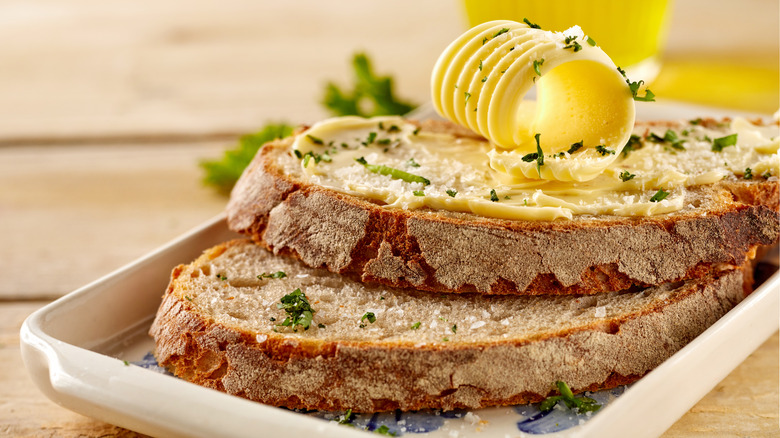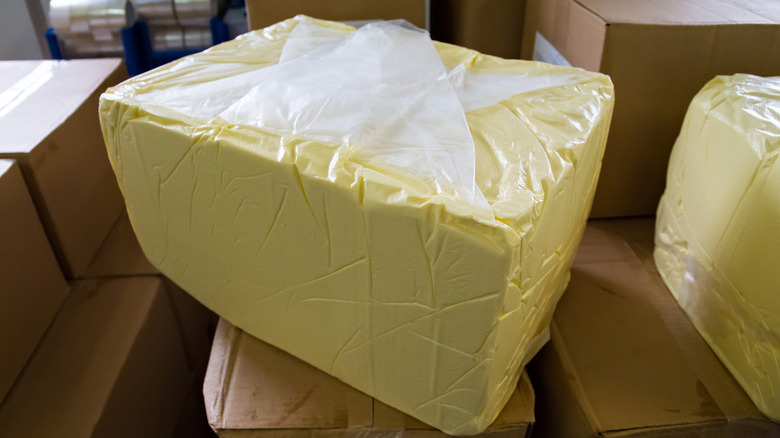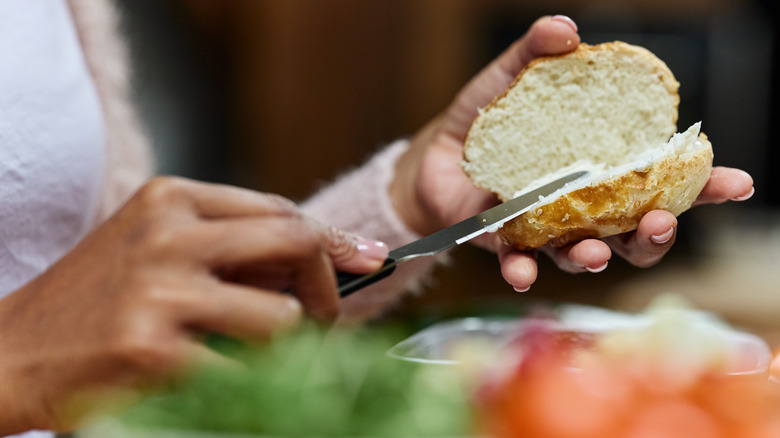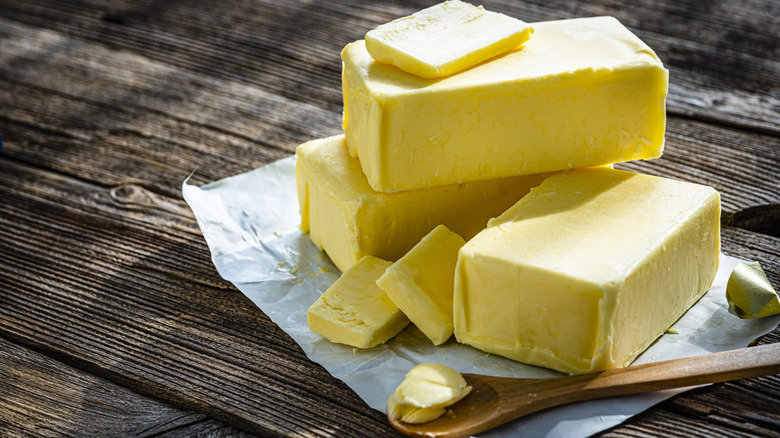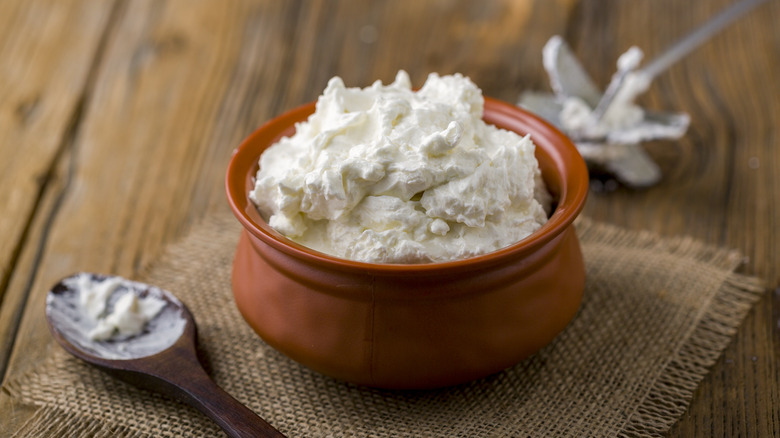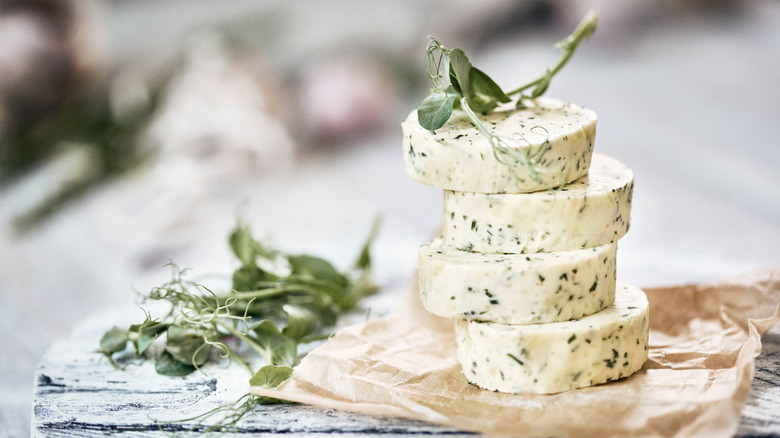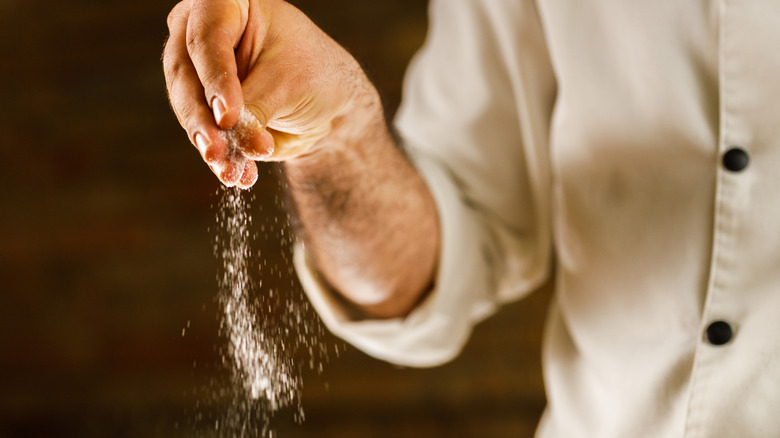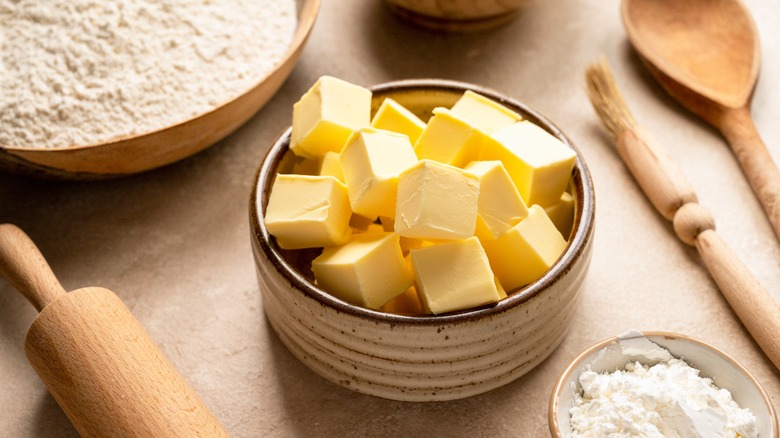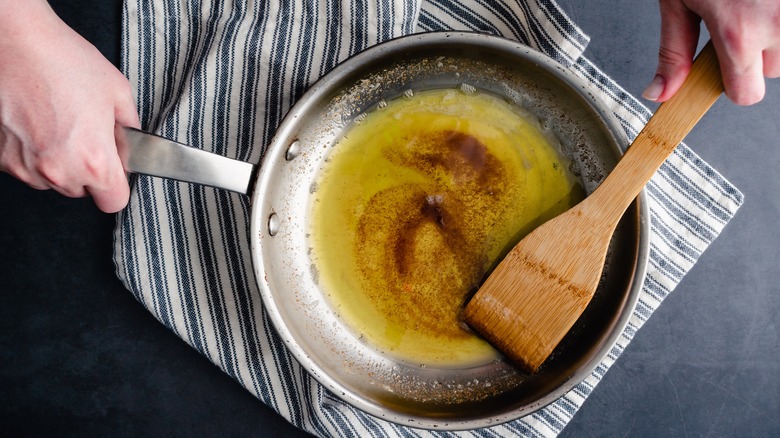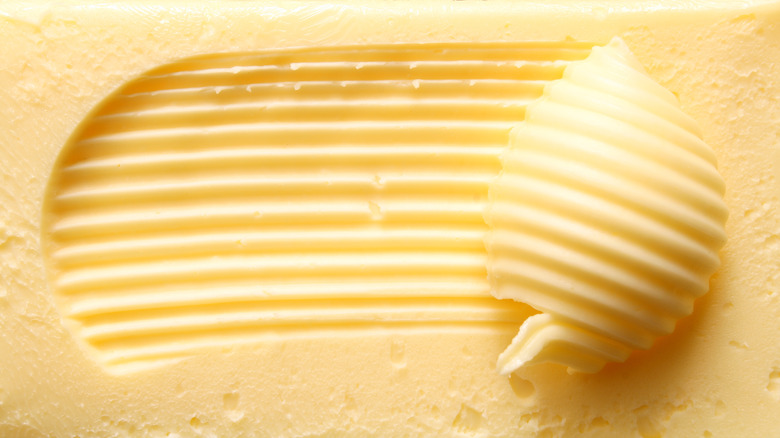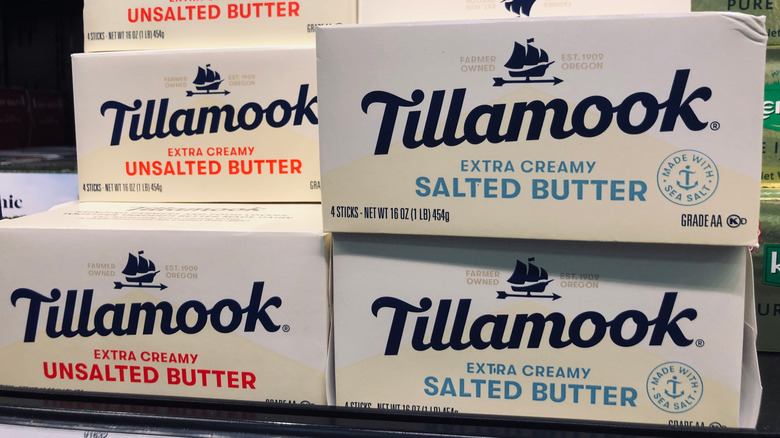Butter Usually Tastes Better At Restaurants. Here's Why
Have you ever bitten into a buttered piece of bread at a restaurant and thought: Wow, this butter tastes so much better than at home? Well, you're not alone. There are several reasons why restaurant butter tastes better. From proper storage to herb infusions to fat content to the amount and style used, restaurants pay close attention to the details. Not all butter is the same, and restaurants know how to maximize its flavor on every level.
To determine why butter often tastes better at restaurants, I referenced various chef opinions and quality standards across the web. I also worked in many restaurants for 20 years. As a result, I have lots of first-hand experience handling, storing, and serving butter to countless guests and know how it differs from home use. Keep reading to learn about all the reasons butter usually tastes better at restaurants so you can start enjoying a boost in butter flavor at home. Or, maybe you just want to share your newfound knowledge the next time you dine out with friends. Either way, you'll be surprised at what you learn.
Restaurants take better care of their butter
You probably don't think much about the proper way to care for your butter at home, but restaurant chefs do. From optimal storage conditions to careful handling to freshness, restaurants make sure butter arrives at your table in the best shape possible. Considering they have pro chefs, experienced line cooks, and well-trained service staff, this isn't much of a surprise, but it does lead to optimal flavor. Just like with any food or ingredient, better handling and more care keep it in pristine condition. Fortunately, you can easily take better care of your butter at home, too, and get a slight lift in flavor.
There are lots of food storage mistakes you can make with butter, and trained chefs are typically better at avoiding them. For example, did you know you shouldn't store your butter in a transparent butter dish because it makes it spoil faster? Exposing butter to light and heat speeds up its deterioration, so keeping it in an airtight, opaque dish away from heat is crucial. In addition, it is best to keep raw, whipped, and unsalted butter in the fridge unless you are softening it for immediate use. Salted butter resists bacterial growth, while other kinds of butter not so much (via Healthline).
Restaurants typically serve butter at room temperature
Most restaurants, at least quality ones, serve slices and packets of butter at room temperature. While this may seem inconsequential, it actually affects the taste just as much as the consistency. When butter isn't cold, it has a richer, creamier taste and texture. Of course, room temperature butter is also soft, allowing you to spread it easier and get more coverage. Softer butter seeps into bread and other food items better, so the yummy taste spreads throughout.
The exact amount of time butter can be left out depends on the specific product and whether or not it contains preservatives. However, as a general rule of thumb, salted butter typically lasts up to 10 days at room temperature if kept in a dark, cool spot. So, an opaque butter dish stored away from the direct light of a window is ideal. Even so, the taste could start to change within a few days. Don't let that discourage you — feel free to keep small amounts of butter at room temperature to achieve a creamier texture. Just make sure to leave as much out as you anticipate using within a few days and nothing more.
Butter is fresher at restaurants
Aside from storage and handling, restaurant butter is almost always fresher than the butter you have at home or even buy from the store. Just like with other foods, the difference between fresh and not so fresh is noticeably different when it comes to taste and texture. Many restaurant suppliers sell fresher butter than you find at the grocery store, which you get to enjoy while you dine. Some restaurants even purchase butter from local vendors, like a dairy, so it is as fresh as possible. To get the freshest butter at home, buy it from a dairy or farmers' market. Some health food grocery stores in your area may even carry butter from a local farm. Or, maybe you'll take this as inspiration to churn your own butter.
Not only is restaurant butter fresher when they get it, but it is pretty much guaranteed that they go through it much faster than you do at home. Even if you have a large family or host a gathering, the chance of you using as much butter as a restaurant does in a single lunch or dinner rush is unlikely. Most restaurants go through butter at an astonishing speed, especially if they make their own baked goods and desserts or serve butter-topped steaks and breakfast items.
Many restaurants buy butter with a higher fat content
In general, restaurants aren't concerned with fat content. They want their food to be mouth-wateringly delicious. One way of doing this is using butter with a higher fat content. It may not be good for you, but butter with more fat tastes delicious. It is richer and creamier, and while it doesn't really affect flavor, it is often more yellow in color. If you buy low-fat butter for home use, the difference in taste between your home supply and a restaurant is even more pronounced.
Butter must be at least 80% milk fat, or it is not considered butter (per the Food and Drug Administration). While the FDA outlines a definite minimum, some butter producers surpass the minimum milk fat content, resulting in a richer flavor. Restaurant chefs are familiar with this concept, so they often purchase butter with more milk fat. In general, European-style butter features 82-83% butterfat, so many people prefer the taste. Some even contain 86% butterfat, leading to a super decadent flavor. You probably won't be able to find an 86% butterfat product at your grocery store, but restaurants don't have trouble contracting with the right suppliers. If you look closely, you may find a European-style butter with 82% butterfat at your local grocery store.
Some restaurants whip their butter
Many restaurants serve whipped butter alongside their rolls and other food. While it looks appealing to the eye, it also has a distinct texture and taste. Whipped butter retains air while it is being whipped. The newly aerated, fluffy butter results in a distinguishable flavor and feel in your mouth. The different consistency tastes amazing on some dishes, particularly baked goods like pancakes and dinner rolls. Some chefs may also use whipped butter when creating their recipes, but due to the additional air and volume, it can't be measured like regular butter.
To make whipped butter at home, all you need is butter, a couple spoonfuls of milk or water, and a mixer of some kind. Start by putting softened butter in a mixing bowl, preferably some that has been left at room temperature for at least a couple hours. Then, add a small spoonful of milk or water and start mixing. A whisk works in a pinch, but a hand or stand mixer will make the job much easier and faster. If needed, add another spoonful of milk or water and mix until the butter reaches the ideal fluffy texture.
Many chefs infuse their butter with tasty flavors
Plain butter is tasty enough on its own, but many chefs also infuse their butter with other ingredients to make compound butter, which turns the flavor up to the max. The great thing about this is that butter is versatile and can be used in a myriad of dishes. So, everything from honey to cinnamon to garlic to citrus to an array of herbs and spices makes a delicious complement. Additionally, making compound butter is incredibly simple. All you have to do is whip it with the desired flavor enhancer. And, of course, this gives butter a fluffy texture, further adding to the yummy taste.
Honey butter is a surefire winner for making plain dinner rolls burst with flavor. Just about any flavor goes with bread, but the sweetness of honey adds a Southern comfort twist loved by many. Caramelized onion, garlic, sage, rosemary, and lemon zest are also common compound butter flavors. You can even infuse butter with alcohol or bone broth for a more unique taste. Boozy compound butter tastes phenomenal on steak, other meaty creations, and creamy pasta sauces. For the perfect complement to sweet breakfast foods, like waffles or pancakes, try making a compound butter with lemon and orange zest, cinnamon, or nutmeg.
Chefs sprinkle a little extra salt on top of their butter
Salt enhances the flavor of food, so making a recipe without at least a little bit of salt is nearly unheard of. With this in mind, many chefs enrich the flavor of their butter by adding a sprinkle of salt to the top. If you get a ramekin of butter sent to the table along with bread, for example, added salt is not unusual. If you order a steak and it comes with a slab of butter on the top, it is pretty much guaranteed to have a sprinkle of salt.
If you want to sprinkle salt on pats of butter at home, you can use many different types of salt. Kosher salt is a favorite of chefs for things like steak and seafood, but sea salt, smoky salt, and just plain table salt also taste yummy with butter. Don't get hung up on the details, though — use whatever kind you have in your kitchen and see if it reminds you of restaurant butter. If so, experiment with other types of butter (and salt) until you find the perfect flavor for your palate.
Chefs probably use more butter than you do at home
This probably isn't much of a surprise, but restaurants typically use more butter on their dishes than you do at home. Chefs also cook many of their selections in butter instead of vegetable or olive oil. Considering how more butter equals more yummy flavor, this just makes sense. After all, they want you to keep coming back for more, right? Think about how restaurants serve steaks with a large pat of butter on top. Do you do that at home? Also, many restaurant vegetables come glazed in a delicious butter sauce, making them more drool-worthy from the start.
At home, you may feel more responsible for cooking and eating healthier foods — when you dine out, however, you might forego worrying too much about nutrition and the fat content of your meal. So, if you want to give yourself some leniency (at home) and experience a rich buttery taste, go ahead and use more than you normally would or more than a recipe calls for.
Brown butter is a top choice for chefs
You've probably come across a recipe that uses brown butter and asked yourself: Is it really all that different from regular butter? Well, the answer is yes, and restaurant chefs are acutely aware of the difference. Brown butter has a richer, more decadent taste with a toasted flavor profile. It is possible brown butter could blend into recipes and get lost in the mix, but for the most part, the variation in taste is quite noticeable. For example, pasta with a sage and brown butter sauce has a totally different flavor than pasta with plain melted butter and sage.
Making brown butter may seem complicated, but it is quite easy. According to chef Alton Brown, even the color of your pan matters when making brown butter — but as long as you don't leave it unattended, you can easily make brown butter just like a pro chef at home. Simply melt butter in a shallow frying pan on low to medium heat until it starts to turn brown and you are almost done. Some recipes call for the addition of a small amount of stock, but it isn't always necessary. Either way, the key is to keep a close watch and stir it almost continuously to avoid burning. It should be ready in about four to five minutes — when the butter has a brown tone and nutty aroma, you're good to go.
Restaurants might use better quality butter than you
Okay, this one depends on the grade of the restaurant and how you shop, but there is a good chance restaurants use better quality butter than you do at home. It probably goes without saying, but if you opt for discounted butter, it won't taste as good as high-quality butter. In a top-notch restaurant or fine dining establishment, chefs know this, and they order premium butter to ensure a rich flavor in everything they use it with. Obviously, you can't count on premium ingredients being used in a fast food restaurant or lower-quality establishment like an inexpensive chain diner. Still, those aren't the kind of restaurants where you find yourself asking why the butter tastes better anyway.
The next time you shop for butter, it may be tempting to choose a low-priced product, but if you want maximum flavor and a rich, creamy taste, there are better options than cheap butter. Follow the lead of professional restaurant chefs and opt for a premium product. The difference will be apparent in every recipe or piece of buttered bread you enjoy it with. Even if you save the premium butter for prominent uses, like topping a steak or dipping seafood in melted butter, and still use inexpensive butter for baking and other integrated recipes, your cooking will benefit greatly.
Chefs use both salted and unsalted butter
We've talked about several different kinds of butter – compound and whipped butter, for instance — but they all start with either salted or unsalted butter. Depending on the recipe, one type of butter is generally better. Even so, many people only keep one type on hand at home. You may have even stood in front of the butter cooler at the grocery store and wondered which one to buy or if it even matters, and just picked one at random — however, it truly does make a difference. Unlike novice home cooks, restaurant chefs recognize the difference between salted and unsalted butter and use both kinds to ensure they get the best of both worlds. If you think restaurant butter tastes better, this could be one of the many reasons why.
Unsalted butter is best for baking because it allows you to control the recipe and amount of salt with precision. Salted butter is best for just about everything else. From corn on the cob to pancakes to bread, salted butter enhances flavor and adds a richer flavor than its unsalted counterpart. If you don't think you use enough butter at home to keep both kinds on hand, you can easily turn unsalted butter into the salted variety. Simply mix fine-grained salt, like table salt, into softened unsalted butter, and you're off to the races. Just remember that unsalted butter spoils faster, so it is best to keep it refrigerated.

